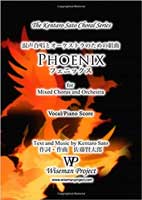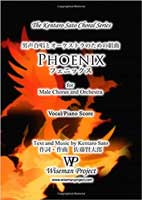A Choral Suite "Pheonix"
for Mixed Chorus
(Chamber Orch. ver., Organ ver. and Piano ver. are available)
合唱組曲「Phoenix(フェニックス)」
混声合唱(オーケストラ伴奏版、小編成オケ版、オルガン版、ピアノ版)
![]()
Text and Music by Kentaro Sato (Ken-P)
based on the text by L. C. F. Lactantius (c.250 - c.325)
作詞・作曲 佐藤賢太郎(Ken-P)
L. C. F. ラクタンティウス (c.250 - c.325) の原詩に基づく
![]()
![]() Full Score SATB (orchestral part of TTBB is the same as SATB version)
Full Score SATB (orchestral part of TTBB is the same as SATB version)
![]() Chorus/Piano ver. SATB (合唱・ピアノ伴奏譜)
Chorus/Piano ver. SATB (合唱・ピアノ伴奏譜)
![]() Chorus/Piano ver. TTBB (合唱・ピアノ伴奏譜)
Chorus/Piano ver. TTBB (合唱・ピアノ伴奏譜)
![]()


All available printed scores from Amazon are listed on the follwoing pages; USA, UK, Germany, Japan, and other Amazon worldwide.
日本国内の製本版楽譜はこちらのページにアマゾン・ジャパンへの全リンクを掲載しています。パナムジカへのリンク先はこちらです。
![]()
click to play audio/ クリックして再生
1. Locus Felix (The Happy Place / 幸せの地)
2. Avis Phoenix (Phoenix, the Bird / 彼の鳥はフェニックス)
3. Mors et Resurrectio Phoenicis (Death and Resurrection of the Phoenix / フェニックスの死と復活)
4. Carmen Phoenici (Song to the Phoenix / フェニックスへの歌)
![]()
YouTube Video List
Mixed Chorus version, Orchestra accompaniment.
Male Chorus version, Organ accompaniment.
![]()
Text/歌詞
Latin / ラテン語
1.
Est locus in primo felix oriénte remótus.
Hic Solis nemus est,
et cónsitus árbore multa lucus,
perpétuæ frondis honóre virens.
Cum Phæthónteis flagrásset ab ígnibus axis,
ille locus flammis inviolátus erat.
Non huc morbi,
non ægra senéctus, nec mors crudélis adest.
Non ibi témpestas nec vis furit venti;
nec gélido terram tegit,
sed fons in médio est,
dúlcibus uber aquis.
Est locus in primo felix oriénte remótus.
2.
Hoc nemus Solis, avis íncolit única Phœnix,
única, sed vivit morte refécta sua.
Paret et obséquitur Phœbo.
Hoc natúra parens munus habére dedit.
Lútea cum primum surgens Auróra
rubéscit rósea luce,
ter quarter
illa pias inmérgit corpus in undas,
ter quarter
e vivo gúrgite libat aquam.
Tóllitur ac summo consídit
in árboris altæ vértice,
quæ totum déspicit una nemus,
et convérsa
novos Phœbi nascéntis ad ortus,
íncipit illa sacri modulámina fúndere cantus,
et mira lucem voce ciére novam.
Lútea cum primum surgens Auróra
rubéscit rósea luce,
íncipit Phœnix sacri modulámina fúndere cantus,
et mira lucem voce ciére novam.
Lútea cum primum surgens Auróra
rubéscit rósea luce,
Phœnix ter alárum repetíto vérbere plaudit
igniferúmque caput ter veneráte,
silet,
antístes luci nemorúmque verénda sacérdos.
In hoc nemóre Solis, Phœnix fulget.
3.
Postquam vitæ iam mille perégerit annos,
assuétum némoris dulce cubíle fugit.
Cumque renascéndi
stúdio loca sancta relíquit,
tunc petit hunc orbem,
mors ubi regna tenet,
ubi per saltus silva remóta latet.
Tum legit palmam;
cónstruit inde sibi seu nidum sive sepúlcrum;
prótinus instrúcto corpus mutábile nido
vitalíque toro membra quiéta locat.
Tunc inter vários ánimam comméndat odóres,
intérea corpus genitáli morte perémptum,
ǽstuat et flammam párturit ipse calor,
procúlque cóncipit ignem: flagrat,
seque ovi terétis cólligit in spéciem.
Inde reformátur
qualis fuit ante figúra,
et Phœnix ruptis púllulat exúviis.
Color est quali vere est,
cum pandit vestes Flora rubénte solo.
Tum ávium stipáta choro révolat illa ad nemus Solis,
movens alas decorátas per grátiam Íridis.
4.
Avis fortunátæ sortis felíxque volúcrum,
cui de se nasci prǽstitit ipse deus!
Felix est.
Mors sola est volúptas:
ut possit nasci, áppetit ante mori.
O Phœnix, avis fortunátæ sortis!
Volat illa, movens alas decorátas per grátiam Íridis.
Ipsa sibi proles, suus est pater et suus heres,
nutrix ipsa sui, semper alúmna sibi.
Ipsa quidem, sed non eádem est,
eadémque nec ipsa est,
ætérnam vitam mortis adépta bono.
Est locus in primo felix oriénte remótus.
Hic Solis nemus est, quo canit Phoœnix.
O Phœnix, avis fortunátæ sortis!
Volâs, movens alas decorátas per grátiam Íridis.
O Phœnix,
nobis fer spem,
ut, sicut tu, carmen hoc renascátur
et nos coniúngat idéntidem hac harmónia.
O Phœnix, avis fortunátæ sortis,
nos coniúngas idéntidem hac harmónia.
![]()
English Translation / 英語訳
1.
There is a happy place, remote, far in the East.
Here is the grove of the Sun,
and a clearing sown with many a tree,
green with the honor of perpetual foliage.
When the axis blazed with the fires of Phaethon,
that place was unhurt by flames.
There is not present here diseases,
nor sick old age, nor cruel death.
There neither tempest nor the force of the wind furies;
nor does frost cover the earth,
but a fountain is in the middle,
teeming with sweet waters.
There is a happy place, remote, far in the East.
2.
In this grove of the Sun, there resides a unique bird, the Phoenix,
unique, but having been remade by her own death, she lives.
She obeys and follows after Phoebus.
Nature, [her] parent, has given [her] this service to perform.
When surging up saffron-yellow Aurora first
reddens by her rosy light,
thrice four times
she immerses [her] body into the pious waves,
thrice four times
she sips water out of the living gulf.
She raises herself up and sits down
in the highest crotch of the tall tree,
the one which looks down on the whole grove,
and, having been turned
toward the new risings of nascent Phoebus,
she begins to pour out the modulations of a sacred song,
to stir up the new light by [her] wondrous voice.
When surging up saffron-yellow Aurora first
reddens by her rosy light,
the Phoenix begins to pour out the modulations of a sacred song,
to stir up the new light by [her] wondrous voice.
When surging up saffron-yellow Aurora first
reddens by her rosy light,
the Phoenix claps thrice by a repeated lashing of [her] wings,
and [after] thrice having venerated [Phoebus’s] fire-bearing head,
she keeps silent,
a presider of the light, and the awe-inspiring priestess of the groves.
In this grove of the Sun, the Phoenix flashes.
3.
After she already has enacted through a thousand years of life,
she flees [her] accustomed, sweet lair of the grove.
And when she leaves behind
the holy places out of [her] eagerness of being reborn,
then she seeks this orb,
where death holds [its] kingdoms,
where, through the thickets, a remote wood escapes notice.
Thence she selects a palm;
thence she constructs for herself a nest or, if you wish, a tomb;
straightway [her] changeable body in the constructed nest
she places and [her] quiescent limbs on the vital cot.
Thence among the various odors, she commends [her] soul,
meanwhiles, [her] body, consumed by a begetting death,
seethes, and the heat itself is in labor with flames,
and from afar it conceives fire: it blazes,
and gathers itself together by rubbings into the look of an egg.
Thence [her] fashioned-shape is reformed
to the sort that it has been before,
and the Phoenix sprouts from the broken [shell pieces] that it shed.
[Her] color is like that which there is in spring,
when Floraspreads [her] garments on the reddening soil.
Then thronged by a chorus of birds, she flies back to the grove of the Sun,
moving [her] wings decorated through the grace of Iris.
4.
Bird of fortunate lot, and happy one of the flying [creatures],
to whom the god himself has guaranteed that she will be born from herself!
Happy is she.
Death is her only pleasure:
so that she may be able to be born, she seeks to die before.
Oh, Phoenix, bird of fortunate lot!
She flies, moving [her] wings decorated through the grace of Iris.
She herself [is]the offspring for herself, she is her own father and heir,
she herself [is] the nurse of herself, always foster-daughter for herself.
She [is] indeed herself, but she is not the same,
and nor is the same one herself,
having reached after eternal life by means of the good of death.
There is a happy place, remote, far in the East.
Here is the grove of the Sun, where the Phoenix sings.
Oh, Phoenix, bird of fortunate lot!
You fly, moving [your] wings decorated through the grace of Iris.
Oh, Phoenix,
bring us hope,
so that, just as you, this song may be reborn
and join us together again-and-again by means of this harmony.
Oh, Phoenix, bird of fortunate lot,
may you join us together again-and-again by means of this harmony.
English Translation by Dr. Robert Zaslavsky
![]()
Japanese Translation / 日本語訳
1.
遥か東方の彼方に幸せの地がある。
そこには太陽の森があり
多くの木々が
常緑の葉をまとう。
パエトーンの炎が地軸を燃やす時も
その地は炎に害されることはない。
そこには病はなく
辛い老いも 残酷な死もない。
そこには嵐も 暴風もなく
地が霜で覆われることもないが
その中心の泉は
甘い水に満ちているのだ。
遥か東方の彼方に幸せの地がある。
2.
この太陽の森に「フェニックス」という類まれなる鳥が
自らの死をもって 唯一の自身を作り直しながら生きている。
彼の鳥はアポロンに付き従う。
彼の鳥の親である自然は 彼の鳥に次のような仕事を与えた
現れたサフランイエローのオーロラが初めて
彼の鳥の薔薇のごとき光で赤く染まる時
三、四回
彼の鳥は神聖なる波に身をゆだね
三、四回
彼の鳥は生きる深淵から水を飲む。
彼の鳥は身を起こし
森全体を見渡せる高木の
最も高い枝根に留まり
そして 起きたばかりのポイポスの
生まれたばかりの光に向き合い
彼の鳥は聖なる歌を素晴らしき音色でさえずるのだ、
その新たな光を混ぜるために。
現れたサフランイエローのオーロラが初めて
彼の鳥の薔薇のごとき光で赤く染まる時
フェニックスは聖なる歌を素晴らしき音色でさえずるのだ、
その新たな光を混ぜるために。
現れたサフランイエローのオーロラが初めて
彼の鳥の薔薇のごとき光で赤く染まる時
翼を三度羽ばたかせ
火をまとうアポロンの頭を三度あがめた後
彼の鳥は沈黙する、
光の統率者 そして 畏敬の念を集める森の聖職者として。
この太陽の森でフェニックスは輝いているのだ。
3.
一千年の時を生きた後
彼の鳥は心地よき森の巣を去る。
彼の鳥は自らの再生のために
聖なる地から離れる時
彼の鳥は
死が支配する地
生い茂る闇が木々を覆い隠す地を探す。
そこで彼の鳥は 一本のシュロの木を選び
そこに巣、いや墓を作るのだ。
彼の鳥は自らを沈め
静かなる翼を命の寝台にゆだねる。
様々な芳香の中に 彼の鳥は自らの魂を託す。
その時 彼の鳥の体は這い出した死とに包まれ
逆巻き そして熱が火種を生み
それは炎となって燃え上がり
そして一つに集まりながら卵のような姿へと形を変える。
そして 彼の鳥はその形を
かつての姿へと再生させながら
フェニックスは卵を破り新たに生まれ出る。
その色はフローラが赤土に
自らの衣を広げる春の様。
そして 鳥たちの合唱に包まれて彼の鳥は太陽の森へと飛んでいく。
アイリスの恵みで彩られた翼を羽ばたかせて。
4.
幸運の鳥、自らより生まれることを神より祝福された
空を翔ける幸せな鳥よ。
幸せなるかな。
死は彼の鳥の喜びなのだ。
新たに生まれるために死を求めるのだ。
フェニックスよ 幸運の鳥よ。
アイリスの恵みで彩られた翼を羽ばたかせて飛んでいく。
自らが子孫 自らが父であり後継者である彼の鳥よ。
自らが里親であり 自らが養子である彼の鳥よ。
彼の鳥は彼の鳥であるが 決して同じではなく
同じ自身であることもない、
死によって永遠の命を手に入れた彼の鳥は。
遥か東方の彼方に幸せの地がある。
その太陽の森でフェニックスは歌う。
あぁ フェニックス 幸多き鳥よ!
アイリスの恵みで彩られた翼を羽ばたかせて飛んでいく。
フェニックスよ
私たちに希望を与えたまえ、
貴方の様に、この歌がまた復活し
私たちがまたこの響きのもとでつながる様に。
フェニックス 幸多き鳥よ
私たちをまたこの響きのもとでつなぎたまえ。
日本語訳・佐藤賢太郎 (Ken-P)
![]()
Instrumentation / 楽器編成
Full orchestra is preferred; however the work can be performed with various combinations of instruments.
• Strings
1st Violins, 2nd Violins, Violas, Cellos, & Double Basses
• with or without 4 or 8 Woodwinds
1 Fl, 1 Ob, 1 Cl, & 1 Bn
or 2 Fl (2nd double Pic), 1 Ob, 1 EH, 2 Cl, & 2 Bn
• with or without 1 Harp
• with or without Timpani & 2 Percussion Parts
*optional 3rd part or 3rd & 4th parts
Glockenspiel, Tubular Bells, Snare Drum, Suspended Cymbal, Piatti, Wind Chime, Triangle, Gong (optional)
• with or without Brasses
4 Hn, 3 Tp, 2 Tb, 1 BTb, & 1 Tu
This work can be performed with the following instrumentation also:
• Organ only, or Orchestral version substituted Strings with Organ
• Piano only (This score), or Orchestral version substituted Strings with Piano
![]()
Program Note (JPN Only) / 初演時プログラムノート
「Phoenix」によせて
本楽曲「Phoenix(フェニックス)」は、今回のコンサートのために書き下ろされた混声合唱組曲です。作品のテーマは、題名にもある『フェニックス(不死鳥)』。歌詞は、3~4世紀にローマ帝国の都市コンスタンティノープル(現在はトルコのイスタンブール)で活躍した北アフリカ出身の作家ラクタンティウスの文章に再構成や文章の追加などを行って制作したものとなります。不死鳥が何度も蘇るように、何度も歌われるような音楽を目指し、合唱の世界共通語であるラテン語で構成した歌詞のもと、浜松から新しく世界に羽ばたく楽曲になるよう制作をいたしました。
第一楽章「幸せの地」では、遥か東方にあるという島「幸せの地」のことを、合唱が管弦楽のゆったりとした波のような音にのせて歌っていきます。
第二楽章「彼の鳥はフェニックス」では、幸せの地に住んでいる不死鳥のことを、合唱が輝く伴奏にあわせて歌いあげていきます。
第三楽章「フェニックスの死と復活」では、死に向かい、そして復活する不死鳥の様子を合唱が神秘的に、時に厳しく、そして優しく歌っていきます。
第四楽章「フェニックスの歌」では、復活した不死鳥に向けた、私たちの希望や願いを合唱がオーケストラの輝かしい音と共に歌っていきます。
今回の機会を頂けたこと、そして演奏に参加していただく音楽家の皆様に感謝するとともに、多くの皆様に楽しんでいただければ嬉しく思います。
![]()
![]()
about the Commission and the Premiere
This work was commissioned by the City of Hamamatsu, (Shizuoka, Japan) for World Music Festival in Hamamatsu 2016. It was premiered by the City of Hamamatsu Joint Chorus, Hamamatsu Symphony Orchestra & Jr. Orchestra Hamamatsu on Nov. 3, 2016, conducted by the composer.
The male chorus version was commissioned by the Meiji Univ. Glee Club, and piano accompaniment version was premiered by the Club on May 6th, 2017 (conductor: Kentaro Sato, piano: Hiroshi Matsumoto). The organ accompaniment version was premiered by the Club on Dec 15, 2017 (conductor: Kentaro Sato, organ: Eri Niiyama).
委嘱・初演に関して
本楽曲は、浜松市による世界音楽の祭典IN浜松のための委嘱作品で、浜松市合同合唱団・浜松交響楽団・ジュニアオーケストラ浜松により、作曲家の指揮のもと2016年11月3日、交流コンサート「Chorus X Symphony」にて初演が行われました。
男声合唱版は、明治大学グリークラブにより委嘱され、同団により2017年5月6日第66回東京六大学合唱連盟定期演奏会にてピアノ伴奏版が(ピアノ・松元博志)、2017年12月15日第66回定期演奏会にて、オルガン伴奏版(オルガン・新山恵理)が作曲家の指揮のもと初演されました。
![]()
![]()